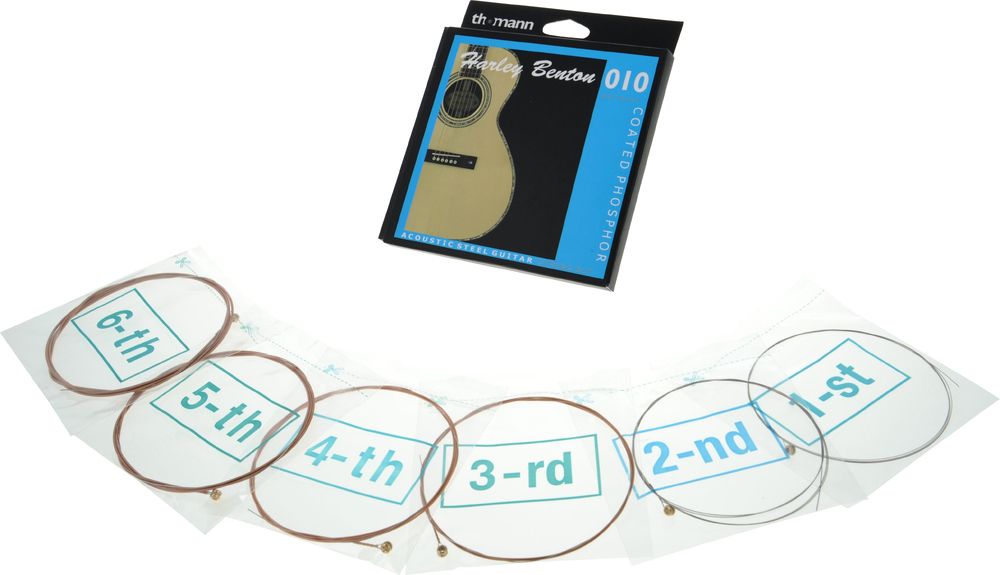5. Sound
The acoustic guitar is always strung with steel strings. These come in different thicknesses, but no matter what, they deliver a solid, vibrant, and shiny sound. If you're playing in a band, the acoustic guitar adds that much-needed brilliance to the upper frequencies, making the whole ensemble sound rich and full. And even when you're going solo, whether you're recording or performing, these steel strings give you a robust sound that'll blow you away! They pack a punch in the lower and middle frequencies too. And when you strum with a pick, get ready for some extra high-frequency goodness.

Harley Benton Coated Phosphor Strings
Thin strings also make the sound thinner! Plus, it can mess with the tuning stability, causing those notes to waver a bit when you press too hard or not hard enough. So, when it comes to playing solo, most musicians prefer thicker strings to get that fuller sound. But when you're jamming with a band, you might want to go for softer, thinner strings to blend in better.
Now, if you're planning to perform on stage, it's a good idea to upgrade your acoustic guitar with a top-notch piezoelectric pickup system or even consider getting an electro-acoustic guitar. And here's a fun fact: The shape of the guitar's body or top can actually give it some unique tonal qualities. You can choose between a flat top or an arched top. The arched top not only adds stability to the instrument but also helps enhance its volume. However, keep in mind that making an arched top requires more effort, so archtop models are generally pricier compared to their flat-top counterparts.
In general:
When it comes to guitars, the type and quality of the wood used have a huge impact on the sound. The top part, which makes the sound come alive, is usually made of spruce wood, split into two symmetrical halves. Back in the day, rosewood was all the rage for the back and sides, but nowadays, mahogany is the go-to choice, although you can still find guitars with maple sides if that's what you're looking for. Mahogany gets the job done for the neck and headstock, while ebony is often used for the fretboard and bridge holder. But get this: Your first guitar doesn't have to be sporting a spruce-top, right off the bat. Even laminated wood can tickle your discerning ears. Although, these days, you can actually find affordable guitars with genuine spruce tops if you want to kick it up a notch! But hey, remember, wood alone isn't a guarantee of amazing sound.
Now, let's talk about the body shape. Unlike classical guitars, there's no one-size-fits-all body shape for acoustic guitars. It's a battle of shapes out there—Jumbo, Dreadnought, you name it. And hey, new body shapes are popping up all the time!
For example, the Dreadnought shape is all about that transparent vocal sound with rich, powerful bass frequencies, perfect for solo pieces! On the other hand, the curvy Jumbo guitar brings out those lower frequencies in a more refined way while also giving some extra love to the midrange. If you're jamming with a band, you might lean towards a smaller-bodied guitar with a cutaway for those high-fret action moments. And of course, you'll want to plug that baby in and crank up the volume with a pickup.
Oh, and let's not forget about the bracing system—the secret sauce that gives each guitar its unique sound. Manufacturers are always showing off their patented bracing designs. But hey, don't go overboard thinking that bracing is the "be-all and end-all" of sound. Initially, the bracing system was all about keeping the top stable...
Even the finish of the guitar plays a part in the sound. You want a finish that's tough and thin to avoid killing the sound, but still flexible enough to handle changes in humidity without cracking like an egg.
Now, here's the trick: You can upgrade your acoustic guitar with a piezoelectric pickup system. Just drill a hole near the center of the body where the strap button sits, and voilà: You're ready to rock! And get this—you don't need a fancy pickup system with all the bells and whistles. You can fine-tune the sound using the EQ on your amp, mixer, or an external EQ.
But hey, there's more than one way to skin a cat! When you're recording a solo piece in the studio, you want a guitar with that natural sound, right? So, ditch the pickup and grab a high-quality microphone to capture all the acoustic sweetness!



